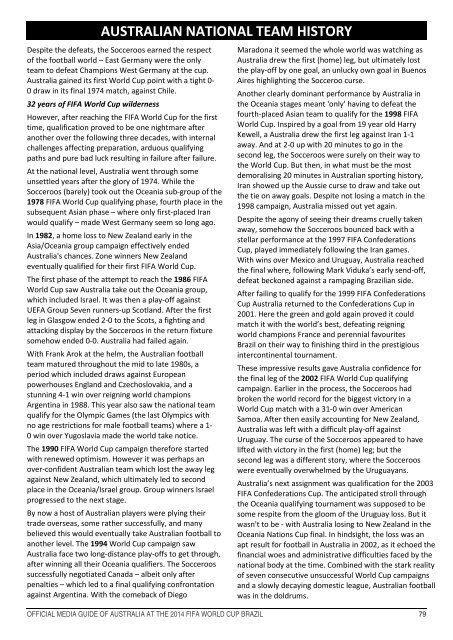AFWC14MG
AFWC14MG
AFWC14MG
- No tags were found...
You also want an ePaper? Increase the reach of your titles
YUMPU automatically turns print PDFs into web optimized ePapers that Google loves.
AUSTRALIAN NATIONAL TEAM HISTORYDespite the defeats, the Socceroos earned the respectof the football world – East Germany were the onlyteam to defeat Champions West Germany at the cup.Australia gained its first World Cup point with a tight 0-0 draw in its final 1974 match, against Chile.32 years of FIFA World Cup wildernessHowever, after reaching the FIFA World Cup for the firsttime, qualification proved to be one nightmare afteranother over the following three decades, with internalchallenges affecting preparation, arduous qualifyingpaths and pure bad luck resulting in failure after failure.At the national level, Australia went through someunsettled years after the glory of 1974. While theSocceroos (barely) took out the Oceania sub-group of the1978 FIFA World Cup qualifying phase, fourth place in thesubsequent Asian phase – where only first-placed Iranwould qualify – made West Germany seem so long ago.In 1982, a home loss to New Zealand early in theAsia/Oceania group campaign effectively endedAustralia's chances. Zone winners New Zealandeventually qualified for their first FIFA World Cup.The first phase of the attempt to reach the 1986 FIFAWorld Cup saw Australia take out the Oceania group,which included Israel. It was then a play-off againstUEFA Group Seven runners-up Scotland. After the firstleg in Glasgow ended 2-0 to the Scots, a fighting andattacking display by the Socceroos in the return fixturesomehow ended 0-0. Australia had failed again.With Frank Arok at the helm, the Australian footballteam matured throughout the mid to late 1980s, aperiod which included draws against Europeanpowerhouses England and Czechoslovakia, and astunning 4-1 win over reigning world championsArgentina in 1988. This year also saw the national teamqualify for the Olympic Games (the last Olympics withno age restrictions for male football teams) where a 1-0 win over Yugoslavia made the world take notice.The 1990 FIFA World Cup campaign therefore startedwith renewed optimism. However it was perhaps anover-confident Australian team which lost the away legagainst New Zealand, which ultimately led to secondplace in the Oceania/Israel group. Group winners Israelprogressed to the next stage.By now a host of Australian players were plying theirtrade overseas, some rather successfully, and manybelieved this would eventually take Australian football toanother level. The 1994 World Cup campaign sawAustralia face two long-distance play-offs to get through,after winning all their Oceania qualifiers. The Socceroossuccessfully negotiated Canada – albeit only afterpenalties – which led to a final qualifying confrontationagainst Argentina. With the comeback of DiegoMaradona it seemed the whole world was watching asAustralia drew the first (home) leg, but ultimately lostthe play-off by one goal, an unlucky own goal in BuenosAires highlighting the Socceroo curse.Another clearly dominant performance by Australia inthe Oceania stages meant 'only' having to defeat thefourth-placed Asian team to qualify for the 1998 FIFAWorld Cup. Inspired by a goal from 19 year old HarryKewell, a Australia drew the first leg against Iran 1-1away. And at 2-0 up with 20 minutes to go in thesecond leg, the Socceroos were surely on their way tothe World Cup. But then, in what must be the mostdemoralising 20 minutes in Australian sporting history,Iran showed up the Aussie curse to draw and take outthe tie on away goals. Despite not losing a match in the1998 campaign, Australia missed out yet again.Despite the agony of seeing their dreams cruelly takenaway, somehow the Socceroos bounced back with astellar performance at the 1997 FIFA ConfederationsCup, played immediately following the Iran games.With wins over Mexico and Uruguay, Australia reachedthe final where, following Mark Viduka’s early send-off,defeat beckoned against a rampaging Brazilian side.After failing to qualify for the 1999 FIFA ConfederationsCup Australia returned to the Confederations Cup in2001. Here the green and gold again proved it couldmatch it with the world’s best, defeating reigningworld champions France and perennial favouritesBrazil on their way to finishing third in the prestigiousintercontinental tournament.These impressive results gave Australia confidence forthe final leg of the 2002 FIFA World Cup qualifyingcampaign. Earlier in the process, the Socceroos hadbroken the world record for the biggest victory in aWorld Cup match with a 31-0 win over AmericanSamoa. After then easily accounting for New Zealand,Australia was left with a difficult play-off againstUruguay. The curse of the Socceroos appeared to havelifted with victory in the first (home) leg; but thesecond leg was a different story, where the Soccerooswere eventually overwhelmed by the Uruguayans.Australia’s next assignment was qualification for the 2003FIFA Confederations Cup. The anticipated stroll throughthe Oceania qualifying tournament was supposed to besome respite from the gloom of the Uruguay loss. But itwasn't to be - with Australia losing to New Zealand in theOceania Nations Cup final. In hindsight, the loss was anapt result for football in Australia in 2002, as it echoed thefinancial woes and administrative difficulties faced by thenational body at the time. Combined with the stark realityof seven consecutive unsuccessful World Cup campaignsand a slowly decaying domestic league, Australian footballwas in the doldrums.OFFICIAL MEDIA GUIDE OF AUSTRALIA AT THE 2014 FIFA WORLD CUP BRAZIL 79





